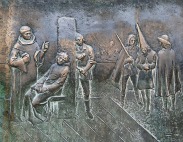
The Spanish Inquisition 1478 – 1834
Throughout history, Spain has drawn the attention of travellers from far and wide, many of whom made the country home and brought with them influences from their own homelands. By the early 13th century, Spain had become a melting pot of cultures and religious beliefs, which the Christian Crusades set out to resolve with the Reconquista or Reconquest of Spain. While the Christians successfully reclaimed some areas, in particular the Moorish strongholds of the Iberian Peninsula, in the cities, multi-religious communities still existed.
King Ferninand II and Queen Isabella I were the monarchs of Spain during this period of religious unrest, and they felt that creating a unified nation through the Catholic religion was the answer. The couple requested permission from the Pope to introduce the Inquisition in an attempt to root out those citizens who practised Judaism, Islam or other non Catholic faiths.
Had it not been for the fact that Rome was at this time being threatened by Turks, and in need of the support of the Spanish military, Pope Sixtus IV may not have issued the Papal Bull giving Ferdinand and Isabella the right to perform the Inquisition in Castile. Signed on the 1st November 1478, the monarchy were able to demand trial of any baptised Christian, particularly those who had converted from one of the forbidden religions.
In 1483, the role of Inquisitor General was given to Tomas de Torquemada, a Dominican friar. It was up to him to organise Inquisitor groups in the cities and direct their actions. Torquemada quickly became one of the most hated men in Spain, bringing a reign of terror to the country as he hunted down heretics who practised their old beliefs. Historians have estimated that the Inquisitor General was accountable for more than 2,000 deaths during his 15 years of work.
The results of the Spanish Inquisition were the most brutal of their kind. An atmosphere of tension and fear grew as people were encouraged to accuse neighbours. Anyone who broke the religious laws by following the ways of Judaism could be reported to the Inquisitors. False accusations were common, and those denounced usually had no idea who had pointed the finger at them. Those accused faced imprisonment, torture, trial and in many cases, were burnt at the stake.
This dark period of Spanish and Christian history lasted until 1834, when a Royal Decree was issued to prevent further the Inquisition from continuing. Thankfully, today’s Spain is a place where all religions are welcomed with open arms, though curious visitors can get a sense of what life was like during the Inquisition at Castillo San Jorge Museum, in the Triana area of Seville.
 Follow
Follow


